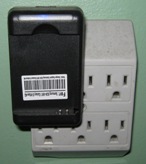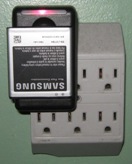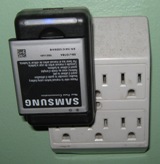| POLICIES AND PROCEDURES
GPS Unit Power
Removable Batteries • Units Powered by Standard Removable Batteries
Units Powered by Non-Standard but Removable, Rechargable Batteries
Units Powered by Internal Rechargeable Batteries

Running out of power is the most common way GPS units fail on the
road and is a problem that is best prevented through proper planning
beforehand. It is absolutely critical that you ensure your individual
GPS unit will have enough power to last throughout the ride before
you depart that day because we cannot guarantee that you will be able
to charge or buy any batteries on the road and we cannot charge any
individual GPS unit in our vehicles if you run out of power.
- Click
Here for more information about our Support Vehicle
policies.
|
We strongly recommend testing how long it takes your GPS unit to run out
of power well before the start of the event so you know how long it will
operate on a full charge and also how long it will take to fully recharge
your unit's batteries. That way you can make sure your unit will have
enough power for the entire event and be prepared accordingly.
Removable Batteries
If your GPS unit uses removable batteries, you should always carry at least
one extra set (preferably two) of fresh, fully charged spare batteries with
you on your bike so that you are fully prepared in case your unit runs out
of power.
We feel it is best to wait until the unit completely runs out of power before
replacing the batteries in order to maximize the unit's usage time.
This also prevents mixing up batteries and accidentally using ones that are
only partially charged, particularly if your GPS unit uses two or more of
the same batteries. Otherwise you can place fresh, fully charged batteries
in the unit before the ride if you prefer to have the maximum amount of continuous
riding time without having to change the batteries.
We also recommend coming up with a system for knowing whether your batteries
are fully charged or not. For disposable batteries we recommend just keeping
new ones in their original package and discarding them as they get used up
as soon as possible so that you don't mix new and used batteries. For
rechargeable batteries, we recommend numbering each battery with a permanent
marker so it is easier to track which batteries are fully charged and which
ones need to be.
And even if you know exactly what to expect with your unit's operation
and/or are carrying extra batteries with you on the road, it's still
best to conserve power anyways just in case because you never know when a
battery might unexpectedly die.
Units Powered by Standard Removable Batteries (e.g. Garmin eTrex and GPSMap60
series units)
Units powered by standard, removable batteries (AA, AAA, 9V, etc.) are unquestionably
the best option. These types of batteries are light, inexpensive, easily
replaced, and readily available anywhere. If you completely run out of batteries
you can run into almost any store and buy new ones in an emergency, and you
can use any extra batteries left over after the event for lots of other purposes
around the house.
If your unit uses standard, removable batteries we recommend using disposable
batteries instead of rechargeable ones, particularly for multi-day events.
Doing so eliminates having to bring a battery charger, plugging it into a
wall outlet, and keeping track of which batteries are charged or not. If
you do decide to recharge your batteries nightly on a multi-day event, we
recommend bringing a charger that can show you when the batteries are fully
charged (such as a light that changes color, etc.) and that can charge double
the amount of batteries your unit uses (i.e. a four battery charger for a
unit that takes two batteries) to ensure you can always carry an extra fully
charged set of batteries with you on the road.
 |
- Click
Here for the battery charger we recommend and also use
in our support vehicles. Not only can this charger charge four AA,
AAA, D, or D batteries at one time, it can also charge 2 additional
9V batteries at the same time and run off of either wall or car power.
We've been using this fantastic versatile battery charger for years
and absolutely LOVE it!
|
We also recommend initially packing a full set of new or fully charged batteries
necessary for the entire event (plus a couple extras) in your baggage so
you won't have to worry about any buying extra batteries or recharging them
during the event.
We will carry extra standard disposable batteries in our vehicles as a "part" according
to our mechanical support services policies.
- Click
Here for more information about our our mechanical support
services.
- Click
Here for
more information about our parts
and accessories we have for sale.
Units Powered by Non-Standard but Removable, Rechargable Batteries (e.g.
smartphones such as the Samsung Galaxy series)
 The battery in these types
of units is rechargeable and can be easily removed, but is not a standard
battery type (AA, AAA, etc.) In order to recharge
it you can either plug a power cable into the unit or you can just swap out
the battery with a fresh, fully charged one. The battery in these types
of units is rechargeable and can be easily removed, but is not a standard
battery type (AA, AAA, etc.) In order to recharge
it you can either plug a power cable into the unit or you can just swap out
the battery with a fresh, fully charged one.
If you only have one battery for your unit, it is absolutely critical that
you bring a way to charge it with you such as a wall charger. If you do not
remember to plug the unit in and fully charge it the night before the ride
and it runs out of power, you will not be able to use it at all.

Wall Charger |
|

Battery is charging |
|

Battery is fully charged |
For these types of units we strongly recommend purchasing at least one extra
battery (possibly 2) and an additional separate wall charger just for the
battery (see pictures above). That way you can charge two batteries at
one time and carry at least one extra fresh, extra fully charged spare battery
with
you
on the
road.
Ideally, the wall charger will also indicate when the battery is fully
charged (see pictures above). Extra batteries and chargers can easily be
purchased online or at a specialty store,
such
as
a cell phone
store.
Otherwise
if
you do
not
purchase
a separate
charger, you will need to swap out the batteries after one becomes fully
charged.
Units Powered by Internal Rechargeable Batteries (e.g. Garmin Edge and Forerunner
series units and smartphones such as the iPhone)
The battery in these types of units is internal and cannot be easily removed
and replaced. In order to recharge the unit you have to plug a power cable
into it, such as a wall charger, USB computer cable, or 12V car charger.
We do not recommend using these types of units because it is absolutely
critical that you bring a way to charge it up with you and also remember
to plug the unit in and fully charge it the night before the ride. Otherwise
you will not be able to use your unit at all because it cannot be quickly
or easily charged on the road. |

